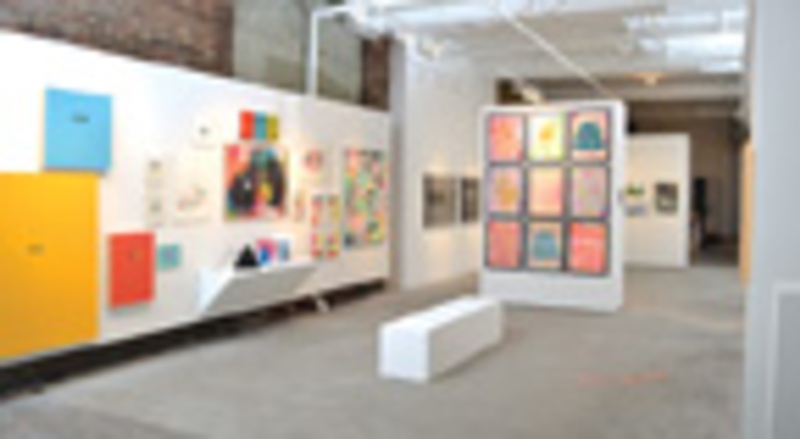As a critic, I hesitate to read too much into any particular show — my rule of thumb is that if you can’t see it in the work, it probably isn’t there. I say this because I’m keenly aware that humans have an unparalleled capacity for uncovering profundity were only the banal exists, and I’ve seen far too many shows where the gulf between what the artist says the work is about and the work itself looks wider than the Grand Canyon at the south rim.
Visual art is after all, first and foremost visual.
But for Night and Day, a two-person show by Brooklyn-based artists Mike Perry and Naomi Reis currently on view at the gallery/shop/studio YES, I’ve let my guard down a little. The temptation to experience something approaching the sublime beneath the surface of lighthearted illustrations wrapped in psychedelic colors or brittle, architectural depictions of a modernist sphere was just too strong.
Whether found in Perry’s voluminous portrayals of cartoonish alternate realities or in Reis’ technical drawings of the portal that takes you there, these artists’ works are imbued with an acute longing to escape.
A designer and illustrator, Mike Perry is “kind of a big deal.” Counting corporate giants such as Nike, Target and Apple as clients, he’s published several books that anthologize different aspects of design-related art. His contributions to Night and Day encompass a bewildering variety of paintings, drawings, prints and sculptures that are displayed salon-style throughout YES’s crisp gallery space.
These prismatic works are highly seductive. In drawings like the joyful “Hot Tub” or the dynamic “Journey,” Perry deploys color in a Kandinsky-like manner, casually dispersing blue, red and green dollops across the paper’s surface without using it to describe the trees, pools, ladders and odd figures these lively images depict.
Perry’s characters — on view in both two-dimensional and sculptural iterations — are triangular forms that sprout faces and legs, owing a debt to the satirical Klansmen that appear in painter Philip Guston’s work from the late 1960s and ’70s. But the similarity is formal only. Perry’s work is too consistently carefree, reveling in the ecstasy of creation, to really tackle such heavy subject matter. In his child-like drawings we encounter an Eden free from the sorrow and pain that afflicts our world.
In his “Eye See You” series, the separation between our universe and the one that Perry fashions is made palpable by works whose solid-hued surfaces are interrupted by two peepholes. Peering through the piece’s apertures reveals the contours of an illuminated land populated by Perry’s stylized forms and flat planes of saturated color. By keeping us removed from the otherworldly surface beneath, Perry’s works suggest that the utopia on the far side of the wall — an idyllic paradise we all long for — can be glimpsed, but never truly reached.
Fellow Brooklynite by way of Ohio and Shiga, Japan, Reis’ contributions to Night and Day are a more subtle and sinister counterpart to Perry’s all out invocation of joie de vivre.
“Burst #1” and “Burst #2,” both white charcoal drawings on black etching paper, depict with icy reserve the event horizon and crushing center of some black hole–like spatial anomaly. In these works the idea of escape is seasoned with danger, the viewer never knowing what’s on the other side or if he will survive the journey through.
A hint at what lies beyond is witnessed in her three graphite and cut-paper “Broken Geodesic Spheres.” In them, tightly rendered orbs that would make Buckminster Fuller proud float ominously in an ambiguous white space, their surface sliced and pulled open to reveal a cryptic blank interior.
Here Reis appropriates the language of 20th century design, a vocabulary saturated with transcendent political ideals, and puts it in the service of something both elusive and vaguely menacing, suggesting that what we might find on the other side of the portal may be worse that what we’ve fled.
With a bright future getting harder to imagine, the pieces in Night and Day are emblematic of a desire to escape a world that seems forever perched upon the precipice of its own demise. Stuck as we are on this tragic and often pitiless globe, for a few fleeting moments this remarkable exhibition offers us a way out.
NIGHT AND DAY continues at YES Gallery through July 20. 1417 Main St., Over-the-Rhine, yescincinnati.com.






